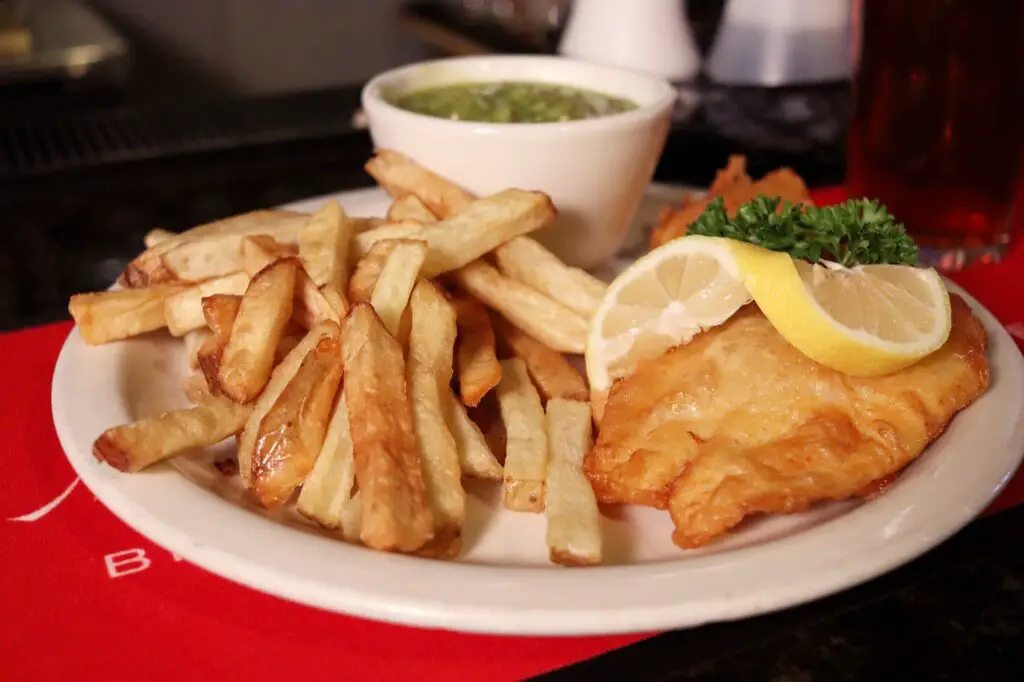When it comes to British cuisine, many people immediately think of fish and chips, full English breakfasts, or Sunday roasts. However, the UK’s culinary landscape is as diverse as its history, filled with unique dishes that may not have gained international fame but are quintessentially British. One such dish that many foreign people might not have heard of is “Stargazy Pie.”
Stargazy Pie is a traditional Cornish dish that combines maritime heritage with rustic charm. Originating from the village of Mousehole in Cornwall, this pie is made with pilchards (or sardines), eggs, and potatoes, encased in a pastry crust. What sets Stargazy Pie apart is its distinctive presentation: the fish are arranged with their heads protruding through the pastry top, “gazing” towards the stars. This not only adds an eye-catching element to the dish but also serves a practical purpose, allowing the oils from the fish to flow back into the pie, enriching its flavor.
The origins of Stargazy Pie are steeped in local legend, most notably tied to the story of Tom Bawcock, a fisherman who braved stormy seas to catch enough fish to feed the starving villagers of Mousehole. The pie is said to commemorate his heroic catch and is traditionally eaten during the festival of Tom Bawcock’s Eve on December 23rd.
While the thought of fish heads staring up from a pie might not appeal to everyone, Stargazy Pie embodies the spirit of Cornish cooking, showcasing local ingredients and a connection to the sea. Its unusual appearance and deep-rooted history make it a fascinating example of a typically British dish that many outside the UK may not be familiar with.
Beyond its quirky presentation, Stargazy Pie represents a celebration of community and resilience, themes that resonate deeply within British culinary traditions. So, while it may not be as widely recognized as other British dishes, Stargazy Pie holds a special place in the hearts of those who cherish the rich tapestry of UK regional cuisine.
Building on the intrigue of Stargazy Pie, British cuisine offers a plethora of unique dishes that showcase the diverse culinary landscape of the UK. Here are a few more traditionally British dishes that might not be as well-known internationally but are cherished across the British Isles:
Bedfordshire Clanger
The Bedfordshire Clanger is a unique, dual-purpose pastry that originated as a convenient meal for farm workers in the 19th century. It features a suet crust pastry filled at one end with a savory mixture, typically meat and potatoes, and at the other end with a sweet filling, such as jam or fruit. This ingenious design allowed workers to enjoy a two-course meal on the go, with the savory end eaten first, followed by the sweet.
Singin’ Hinnies

Singin’ Hinnies are a beloved treat from the North East of England, particularly associated with Northumberland. These griddle cakes or scones are made with flour, butter, lard, currants, and baking powder. They’re called “Singin’ Hinnies” because of the sizzling or “singing” sound they make when cooking on the griddle. Best served hot, they’re often enjoyed with a dab of butter.
Cullen Skink
Hailing from Scotland, Cullen Skink is a thick soup known for its rich and comforting qualities. It’s made from smoked haddock, potatoes, onions, and cream. Originating from the town of Cullen in Moray, on the northeast coast of Scotland, this soup is a staple of Scottish cuisine, offering warmth and nourishment against the backdrop of Scotland’s cold, windy weather.
Laverbread
Laverbread is a traditional Welsh delicacy made from laver, a type of seaweed. After being boiled for several hours, the seaweed turns into a dark green paste, which is then often mixed with oatmeal and formed into cakes that are fried. Laverbread is commonly served at breakfast alongside bacon and eggs and is a rich source of vitamins and minerals.
Eccles Cake

Originating from the town of Eccles in Greater Manchester, the Eccles Cake is a small, round pastry filled with currants, sugar, spices, and sometimes topped with demerara sugar. The flaky, buttery pastry combined with the sweet filling makes it a popular snack or dessert, enjoyed with a cup of tea.
These dishes, from the savory and ingenious Bedfordshire Clanger to the sweet, flaky Eccles Cake, represent just a fraction of the diverse and regionally distinct cuisine found across the British Isles. Each dish tells a story of the local landscape, traditions, and history, offering a deeper appreciation for the rich culinary heritage of the UK beyond its most famous exports.
While specific recipes can vary, I’ll provide estimated nutritional facts for the dishes mentioned, giving you a general idea of their caloric and nutritional content. These estimates are based on traditional recipes and common serving sizes. It’s important to remember that actual values can differ based on ingredients and portion sizes.
Bedfordshire Clanger
Calories: 600-800 per serving
Protein: 20-30g
Carbohydrates: 80-100g
Fat: 25-35g
Fiber: 3-5g
Singin’ Hinnies
Calories: 250-350 per serving
Protein: 4-6g
Carbohydrates: 35-45g
Fat: 10-15g
Fiber: 1-2g
Cullen Skink
Calories: 300-400 per serving
Protein: 18-25g
Carbohydrates: 20-30g
Fat: 15-25g
Fiber: 2-4g
Laverbread
Calories: 50-100 per serving (not including accompaniments)
Protein: 2-5g
Carbohydrates: 10-15g
Fat: 0.5-1g
Fiber: 5-10g
Eccles Cake
Calories: 220-320 per cake
Protein: 3-5g
Carbohydrates: 35-50g
Fat: 10-15g
Fiber: 1-3g
These estimates provide a rough guide to the nutritional content of each dish. The high-calorie counts for some items reflect their origins as hearty meals designed to sustain people through hard physical labor or to provide comfort during cold weather. The nutritional content, particularly for fiber and vitamins, can be beneficial, especially in dishes incorporating whole grains, fish, and seaweed. However, like many traditional dishes, some can be high in fats and sugars, so they’re best enjoyed as part of a balanced diet.




